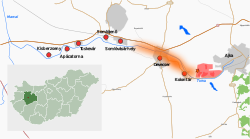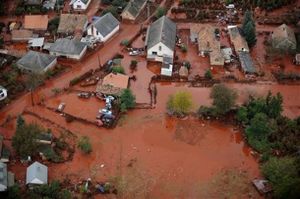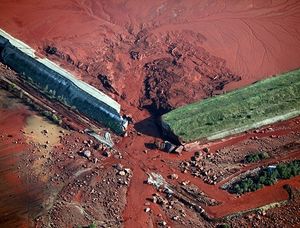انهيار سد الكيماويات بالمجر
هذه المقالة توثق كارثة حالية. قد تتغير المعلومات سريعا حسب تغير الأحداث. ولهذا فيجري العمل على تحديث المقال بشكل متكرر. هذا لا يعكس معظم المعلومات الجارية أو الرسمية عن الكارثة من جميع الأطراف. |
| انهيار سد الكيماويات بالمجر Ajka alumina plant accident | |
|---|---|
 Spill site and affected localities [1] | |
| الموقع | أيكا, المجر |
| الاحداثيات | 47°05′10″N 17°29′49″E / 47.086°N 17.497°E |
| التاريخ | 4 أكتوبر 2010 |
| الأسباب | |
| الخسائر | 4 وفيات, 123 جريح |
| خصائص التسرب | |
| الحجم | ca. 1 مليون م3 (35 مليون قدم مكعب) |
| المساحة | 40 km2 (15 sq. mi.) |
انهيار سد الكيماويات بالمجر هي حادثة صناعية في غرب المجر. في 4 أكتوبر 2010, الساعة 12:25 CEST (10:25 UTC),[2] عند انهيار سد نفايات سامة, مخلفا حوالي مليون متر مكعب (35 مليون قدم مكعب) من المخلفات السائلة, تسمى "الطمي الأحمر," من وحدة Ajkai Timföldgyár الألومينا في أيكا,[3][4] Veszprém County. انطلق الطمي على شكل موجات طول كل منها 1–2 م (3–7 ftقدم) , تدفقت على عدة مناطق قريبة, خاصة قرية كولونتار[3][4]وبلدة Devecser.[3][4][5] وتوفي أربع أشخاص على الأقل, وجرح 123 آخرون.[2][5][6] وتأثرت في البداية حوالي 40 كيلو متر مربع (15 ميل مربع) من الأراضي, وهناك مخاوف من أن يؤثر التلوث على أنهار رابا ودانوب.[5]
منشأ الطمي
The "red mud" that caused the accident is a waste product of the Bayer process for purifying the mineral bauxite into alumina, a form of aluminium oxide. The mud contains most of the impurities in the original bauxite; the characteristic red colour comes from hydrated iron(III) oxide, which is the main component, but it also contains titanium and vanadium compounds[7] along with smaller amounts of other heavy metals.[5] The mud, which is highly alkaline when it is first produced, is stored in large open-air ponds; there is thought to be about 30 million tonnes of red mud stored around the Ajkai Timföldgyár plant.[5]
It was not initially clear how the containment at the mud pond had been breached, although the accident came after a particularly wet summer in Hungary, as in other parts of central Europe.[6] Police have seized documents from the Ajkai Timföldgyár plant, although a spokesman for Hungarian Alumina Production and Trading (MAL Magyar Alumínium Termelő és Kereskedelmi Zrt.), the company that operates the plant, said the last inspection of the pond had shown "nothing untoward".[6] Hungarian prime minister Viktor Orbán said human error—not flooding—likely caused the spill.[8] The series of ponds responsible for the spill were once owned by the government, but have since been privatized, and are owned by one of the richest families in Hungary, giving rise to questions about whether profits were put before safety.[9]
التأثيرات
The wave of mud flooded streets in Kolontár, where four people were confirmed dead, and Devecser, where the flow was powerful enough to move cars and vans.[5][6] The cause of death of the Kolontár victims has not been formally confirmed; a spokesman for the National Directorate General for Disaster Management (NDGDM, Országos Katasztrófavédelmi Főigazgatóság) said that they had probably drowned.[6] A further six people were still missing 24 hours after the accident.[5]
The NDGDM said that the mud was considered hazardous and would cause an alkaline reaction on contact if not washed off with clean water.[6] The mayor of Devecser said that 80–90 people had been taken to hospital with chemical burns.[6] Péter Jakabos, a doctor in the hospital in Győr where many of the injured had been taken, said on Magyar Televízió that it might take days for the full extent of any burns to be realised.[5] Magyar Alumínium (MAL) said that mud was not considered hazardous by EU standards.[6] Initial measurements by the NDGDM showed the sludge to be extremely alkaline, with a pH value of 13.[10]
The chemicals extinguished all life in the Marcal river.[11]
احتواء الكارثة والتنظيف
Apart from the immediate effects of the wave of red mud, there was also concern for a possible contamination of Hungary's waterways. The River Marcal runs through the affected area, and emergency workers were pouring tonnes of plaster into the waterway to try to bind the sludge and prevent it from continuing downstream.[5] The Marcal joins the River Rába at Karakó, in Vas County; the Rába itself joins the Danube at Győr, in Győr-Moson-Sopron County.
The day after the accident, Environmental State Secretary Zoltán Illés ordered the suspension of the alumina production at the plant and the reconstruction of the dam.[12] The following day, the chairman of the company said in a radio interview that he would like to re-start production over the weekend (5–6 days after the Monday accident).[13]
The Hungarian government initially estimated that cleanup would take at least a year and cost tens of millions of dollars.[14]
انظر أيضا
- 2000 Baia Mare cyanide spill
- 1998 Residue dam wall collapse of the Aznalcollar mine
- Aberfan disaster
- Boston Molasses Disaster
- Val di Stava dam collapse
- Hydrography of Hungary
المصادر
- ^ BM Országos Katasztrófavédelmi Főigazgatóság (مجرية)
- ^ أ ب Red mud spill in Veszprém County, www.index.hu, 5 October 2010, http://index.hu/belfold/2010/10/04/iszapomles_veszprem_megyeben/ (مجرية)
- ^ أ ب ت Hungary threatened by 'ecological catastrophe' as toxic sludge escapes factory, Telegraph (UK), October 5, 2010, http://www.telegraph.co.uk/news/worldnews/europe/hungary/8043969/Hungary-threatened-by-ecological-catastrophe-as-toxic-sludge-escapes-factory.html
- ^ أ ب ت Red sludge floods towns in Hungary, Associated Press, October 4, 2010, http://www.msnbc.msn.com/id/39503888/ns/world_news-europe/
- ^ أ ب ت ث ج ح خ د ذ "Hungary declares a state of emergency after sludge disaster", The Guardian, 5 October 2010, http://www.guardian.co.uk/world/2010/oct/05/hungary-sludge-disaster-state-of-emergency.
- ^ أ ب ت ث ج ح خ د Deadly sludge escape kills three in western Hungary, BBC News, 5 October 2010, http://www.bbc.co.uk/news/world-europe-11475361.
- ^ Greenwood, Norman N.; Earnshaw, Alan (1984). Chemistry of the Elements. Oxford: Pergamon Press. p. 245. ISBN 978-0-08-022057-4..
- ^ "Toxic Red Sludge Spill From Hungarian Aluminum Plant 'An Ecological Disaster'", David Gura, NPR, October 5, 2010
- ^ "Hungarians outraged over spill"
- ^ "Sludge-hit Hungarian villagers demand compensation", Atlanta Journal-Constitution, 6 October 2010, http://www.ajc.com/business/sludge-hit-hungarian-villagers-663207.html.
- ^ "Hungarian chemical sludge spill reaches Danube", BBC, 7 October 2010, http://www.bbc.co.uk/news/world-europe-11491412.
- ^ State Secretary Suspends Production, MTI, 5 October 2010, http://mti.hu/cikk/2010/10/05/az_allamtitkar_felfuggesztette_a_mal_zrt-_tevekenyseget-504849 (مجرية)
- ^ "Hungary firm wants to restart production after spill". Reuters. October 6, 2010.
- ^ "Eyewitness: Hungary's toxic spill". BBC. October 6, 2010.

